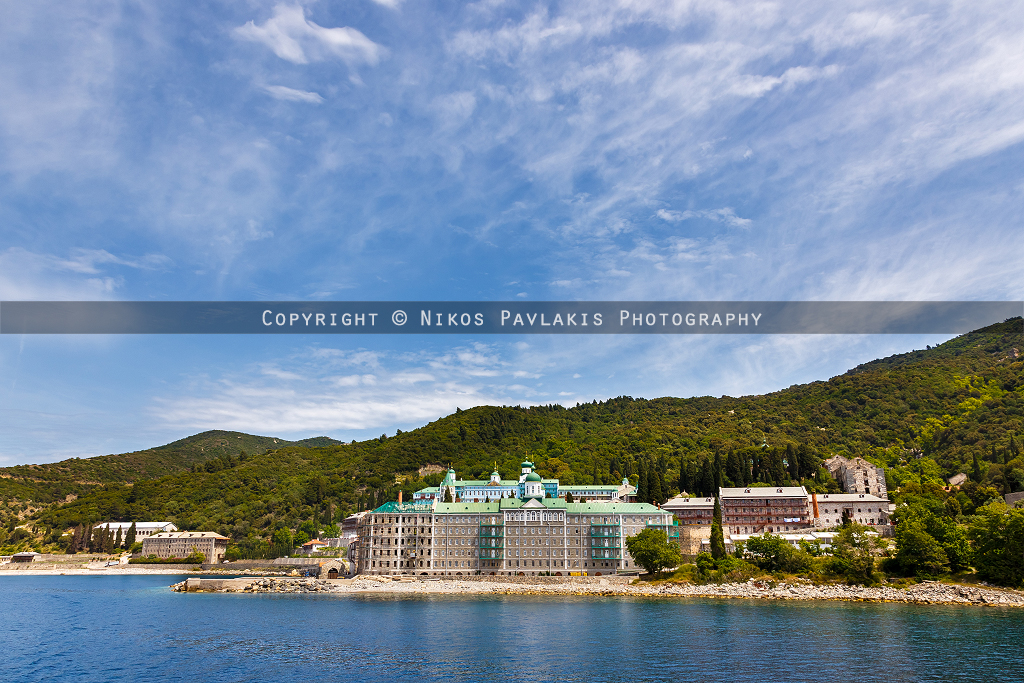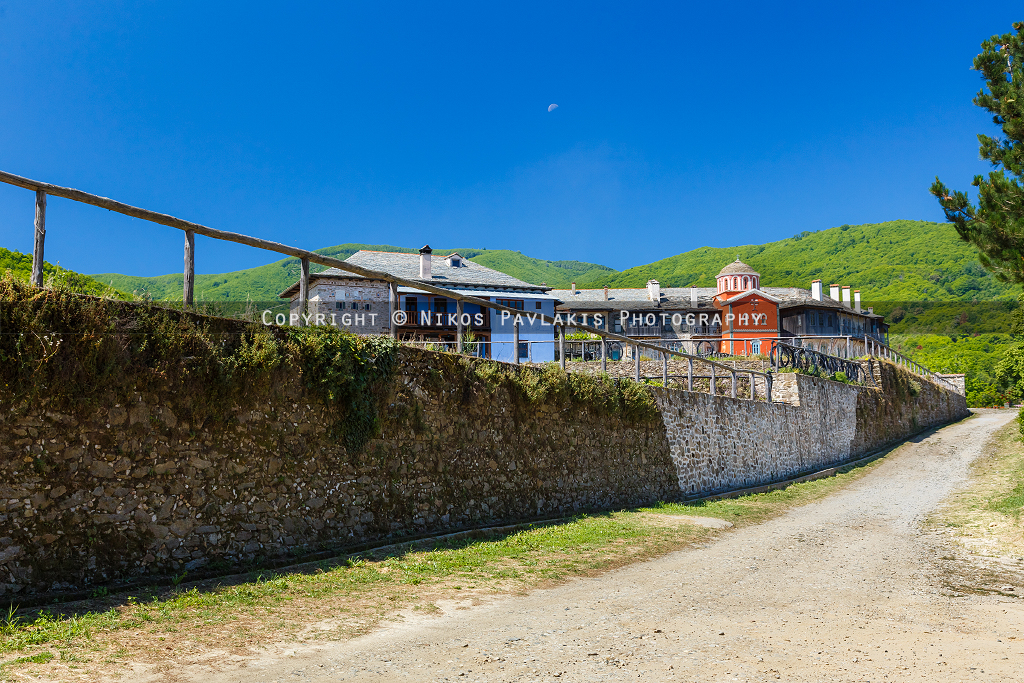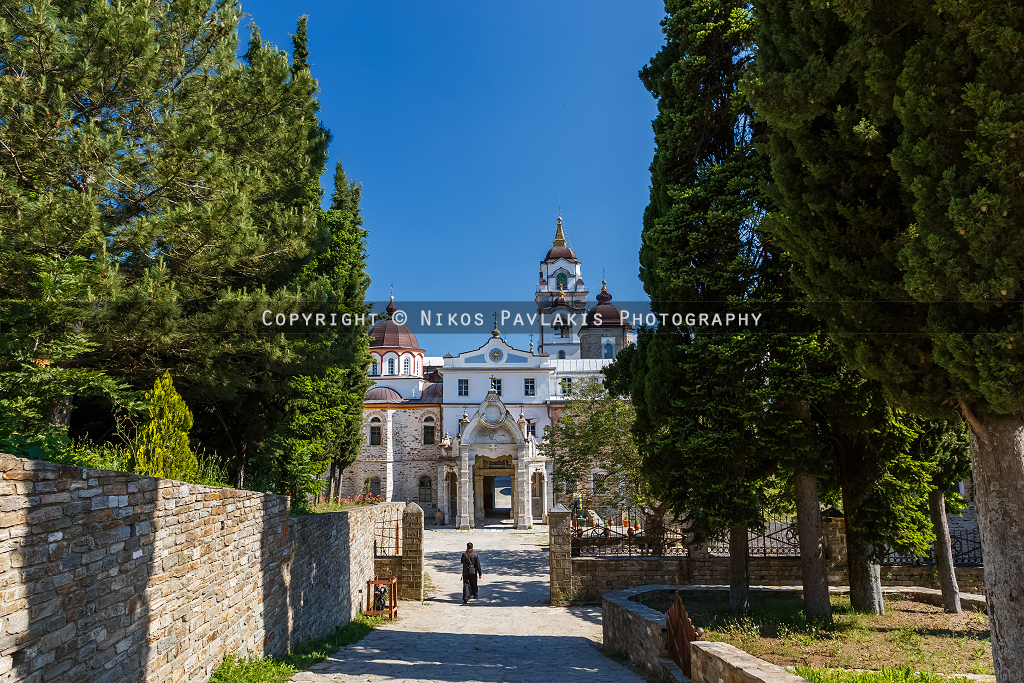The following morning we had an early rise to catch the bus to Ouranoupolis where we would then take the ferryboat to Dafni, then the bus to Karyes and finally one of the mini busses to Megisti Lavra Monastery. The morning resembled something coming out of a fairy tale with pink clouds and blue skies as the sun slowly found its way above the mountains. Almost everyone was sleeping in the bus (or was sleepy like us), but from time to time there were voices talking about that spectacular morning.
Visiting the monasteries of Holy Mount Athos is actually more complicated than you'd think. You have to call 3 months in advance in order to be allowed to enter and stay for 4 nights, then you must call every monastery you want to visit (yes, also 3 months in advance) in order for the holy fathers to make arrangements for you to stay at each monastery for one night, before you continue to the next monastery. Then you must make your reservations for the ferryboat from Ouranoupolis to Dafni, which is the "capital" of Mount Athos (no Dafni is not the capital, Karyes is the capital of Mount Athos), and then from Dafni to the southern monasteries, or from Ierissos directly to the monasteries located at the north.
 |
| New Thebais abandoned Monastery... |
 |
| Port or "Arsanas" of Kastamonitou Monastery... |
 |
| Dochiariou Monastery... |
Arriving at Dafni, you must quickly take the bus to Karyes and from there ask the drivers of the mini busses about which mini bus will leave to your final destination (for the day). When you arrive at the first monastery, you should make new arrangements for your departure the next day for the next monastery you are going to visit. Don't forget this, because usually the distance between the monasteries is far and difficult, espesially under the hot sun of the day. Because of this, remember that you should pack the absolutely essential with you in order to travel light (ok, I brought almost all my photographic gear with me and that made my experience a lot heavier than it would have been otherwise).
 |
| Xenofontos Monastery... |
 |
| Panteleimonos Monastery... |
 |
| Xiropotamou Monastery... |
Having said that, we took the boat to Dafni. We passed along several monasteries with the ferry boat, some abandoned, some distant and deep in the forests . We passed the abandoned New Thebais Monastery, Panteleimonos Monastery, we saw Xiropotamou Monastery high in the mountain, Xenofontos, Dochiariou and Kastamonitou port (or "Arsanas"). The weather was not so good that day, but when we returned there was color everywhere making the buildings stand out from the vast vegetation, a not so pleasant view I must admit.
 |
| Megisti Lavra Monastery... |
 |
| Vivid frescos at Megisti Lavra Monastery... |
 |
| Building details at Megisti Lavra Monastery... |
Arriving at Dafni we immediately headed to the bus and not long after, we arrived at Karyes, the "capital" of Mount Athos, but we had no time to stroll around as the mini busses were leaving to their destinations immediately. Almost two and a half hours later we arrived at Megisti Lavra Monastery with the light still yellowish and the atmosphere cloudy and pale. After leaving our things in our room I headed for the Monastery's port, almost 1,5 Km away and down to the sea. The walking in the heat was worth it, as the little port was built around the green sea making a beautiful sight. But having been trained to "see" and photograph what the rush of time allowed me, I quickly returned to the monastery where I took some more photographs and rested for some time. The next morning the rising sun casting its shadows on the buildings was another memorable moment that I will keep inside me forever. It was one of the few times I ever saw the sun coming out of the sea.
 |
| Port or "Arsanas" of Megisti Lavra Monastery... |
 |
| Morning at Megisti Lavra Monastery... |
 |
| Morning at Megisti Lavra Monastery... |
Our next stop was Karakallou Monastery and we were told that the mini bus cannot go there (later we found out that the driver simply did not want to go there at all), so he left us almost 2 km away and we climbed (oh yes it was a climb alright!) with all our things to the monastery (I was carrying 2 bags with total weight over 30-40 Kg at my back, remember to pack less!). We arrived early enough and we were lucky to be given a double room, but we arrived after the morning lunch and I was surprised from the monks' kind gesture to allow us to eat after everyone had left from the dining tables. You have to keep in mind that at the monasteries of Mount Athos everybody rises up very early in the morning to go to church (at 04:00) and they eat for noon at 07:00, while in the afternoon they go to church at 16:00 and they eat afterwards at 19:00, as they keep pace with Byzantium's old time.
 |
| Karakallou Monastery... |
 |
| Karakallou Monastery building details... |
 |
| Karakallou Monastery central church... |
That night was the first night to see the evening sky with almost all the visible stars! I was not prepared at all for what my eyes were seeing above the dimly lit stone pavement. I was rushing and finally made some badly focused attempts from low angles to capture the central church, the surrounding buildings and the stary sky. I was not happy at all when I saw the misfocused photos later on my computer and there was nothing I could do at that time. So, remember to take your time while focusing and framing your subject.
 |
| Karakallou Monastery building details at night... |
 |
| Karakallou Monastery building details at night... |
 |
| Karakallou Monastery central church at night... |
From Karakallou Monastery almost an hour on foot there is Filotheou Monastery, a small monastery where we stood amazed as we were walking through the main gate. The ground was a green paradise and the colors were so intense that we almost forgot the harsh shadows around us having arrived at high noon. We talked for a while with the head (I think) of the monastery and we were then allowed to photograph "as we wished" the buildings and the gardens, but we missed the lake at the back of the monastery (as we were told later on), something that I regreted even though I came back with a lot of material from Mount Athos.
 |
| Filotheou Monastery... |
 |
| Filotheou Monastery... |
 |
| Filotheou Monastery... |
Next day we headed back to Karyes in order to continue our trip to Vatopedi Monastery, but now we had the time to stroll around and see the old buildings and we went to St. Andreas Skete about 10 minutes away. The Skete houses the priests school or Athoniada (junior high and highschool) and I couldn't help feeling weird seeing these youngsters devoting their lives at God at that young age they were. We were also amazed by the big bells lying on the ground next to the main church, which were decorated with engravements of priests and Holy Mary.
 |
| Athoniada (priest school)... |
 |
| Building details in St. Andreas Skete |
 |
| Engraved icons on large bells in St. Andreas Skete... |
If
you happen to take your camera with you (like I did) remember that you
should not take photos of priests or where it is not allowed
(photographs are not allowed inside most monasteries, but you should
ask). I admit that I tried to take permission to photograph the
architectural details of the monasteries, sometimes with no success,
sometimes with extra rules not to photograph people and sometimes I
tried to photograph at night, when nobody was walking the stone
pavements only to be "caught" in action and be told that I should stop
and return to my room, an unpleasant experience to be truthfull.
 |
| The entrance to St. Andreas Skete... |
 |
| St. Andreas Skete... |
 |
| Building details at Karyes... |
But
how could I leave those intense night images uncaptured? Images of buildings
with the stars visible in the sky in the middle of the night? I couldn't be in terms with myself
when I thought about returning home with these pictures in my head and not
in my camera. Don't get me wrong, I tried to respect the holy fathers,
but I could not find any obvious reason for them to forbid me to take photos of
buildings with the stars in the sky as a background.


























